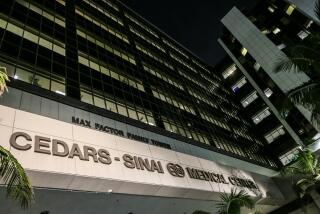Class action filed for Cedars radiation patients
- Share via
Legal action is already underway for the 206 patients who received overdoses of radiation from CT brain scans at Cedars-Sinai Medical Center.
But a class-action lawsuit filed this week on behalf of the victims has little chance of succeeding, several experts said.
“This is the kind of case that the medical liability system doesn’t help us with,” said Tom Baker, a professor at the University of Pennsylvania Law School.
The problem is that the damage from the scans is uncertain. Patients face an increased risk of brain tumors, but radiation experts say that risk is tiny -- especially because it typically takes years or decades for a tumor to develop. The patients, whose median age is 70, are likely to die of other causes.
Many patients experienced hair loss or reddening of the skin, but those effects are usually temporary. The hair loss could be permanent if a patient received multiple scans at the high dose over a short period, according to Christopher Cagnon, chief of radiology physics at UCLA.
Among the 206 Cedars-Sinai patients, 13 had two scans and five had three scans, a hospital spokesman said.
The overdoses stemmed from an error that occurred in February 2008, when the hospital modified the computerized instructions for CT brain perfusion scans, which are used to diagnose strokes. The radiation dose was set at eight times higher than normal. The error went undetected until last August.
Attorneys for the victims said they are likely to focus on the anxiety caused by the overdoses more than on the risk of cancer. Many of the patients are recovering from strokes, and some said they learned of the overdoses only after they were reported in the media.
U.S. courts have generally been unsympathetic in so-called fear of cancer cases, said Robert Rabin, a law professor at Stanford University Law School. The likelihood of future harm must be high, he said.
In a press release this week, Newkirk said that the victims at Cedars-Sinai are “more susceptible to potential cancers and other effects of radiation poisoning than those people who survived the atomic bomb.”
He based his statement on a 2007 study from the New England Journal of Medicine, which included estimates of the radiation exposure of survivors of Hiroshima and Nagasaki a mile or two from the epicenters, a dose similar to that received by the scan victims.
But the author of that study, David Brenner, director of the Center for Radiological Research at Columbia University Medical Center, called the lawyer’s comparison “fallacious.”
Bomb victims suffered a full-body exposure, while the scan victims faced a tightly focused beam of radiation to the scalp and brain. Compared with intestines, breast tissue and reproductive organs, the brain is relatively unsusceptible to radiation.
Brenner estimated that the Cedars-Sinai victims face a roughly one-in-600 chance of a brain tumor for each scan they received.
Rick Patterson, an attorney in Valencia who represents some of the victims said they will file individual lawsuits.
“Each individual has a unique and special claim” that depends on age, number of scans, previous exposure to radiation and other factors, he said.
Patterson blamed the scans for a variety of ailments, including headaches, nausea, tiredness, sexual dysfunction, memory loss and blurred vision. But radiation experts said there is little scientific evidence for those effects. “Certainly not at these levels of radiation delivered to the head,” said Cagnon of UCLA.
The strongest cases probably would be those in which patients suffered permanent damage.
Dana Taschner, attorney for patient TaAnya Carter, said her hair has grown back only in tiny patches.
“I was depressed, embarrassed and wrapped up in self-pity,” said Carter, adding that her left cheek also turned red and she suffered headaches.
When she learned two weeks ago that she had received an overdose, the hospital offered her little comfort, she said.
“I wanted somebody to say, ‘Sorry, we made a mistake,’ ” she said.
--
More to Read
Sign up for Essential California
The most important California stories and recommendations in your inbox every morning.
You may occasionally receive promotional content from the Los Angeles Times.














